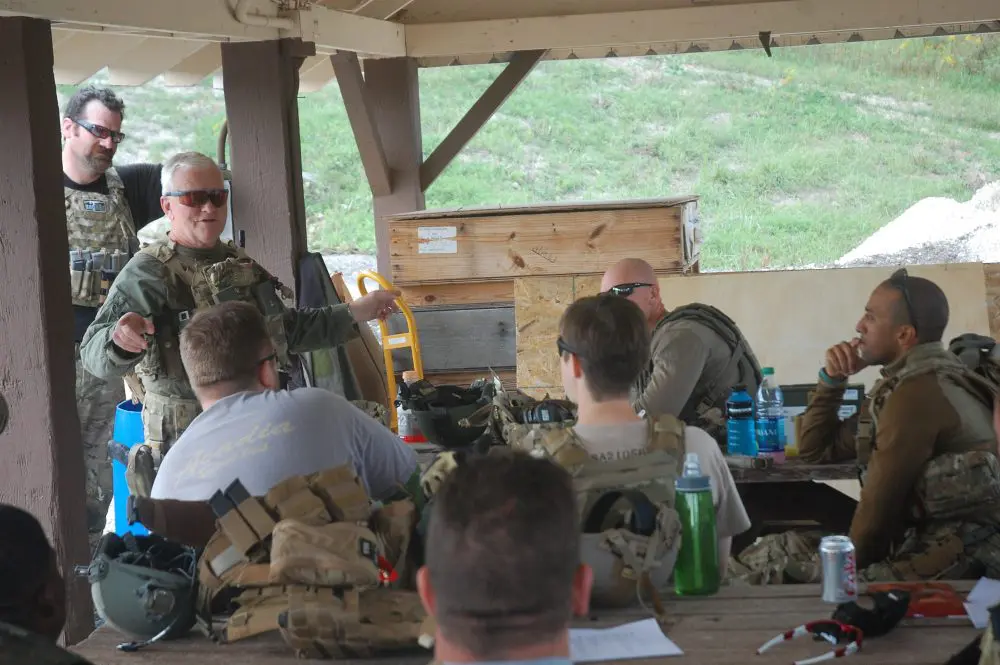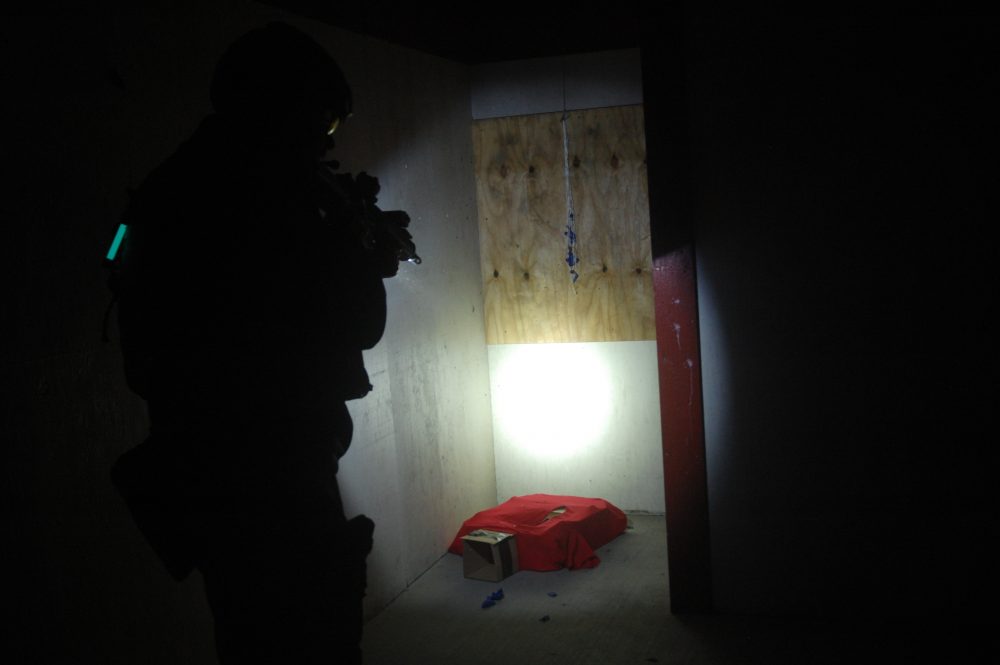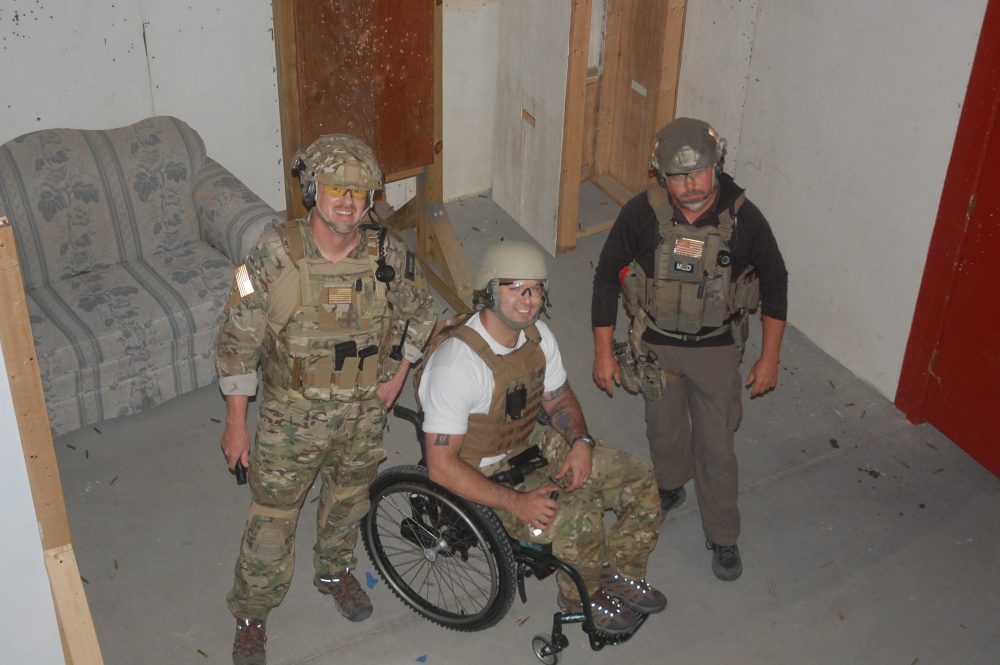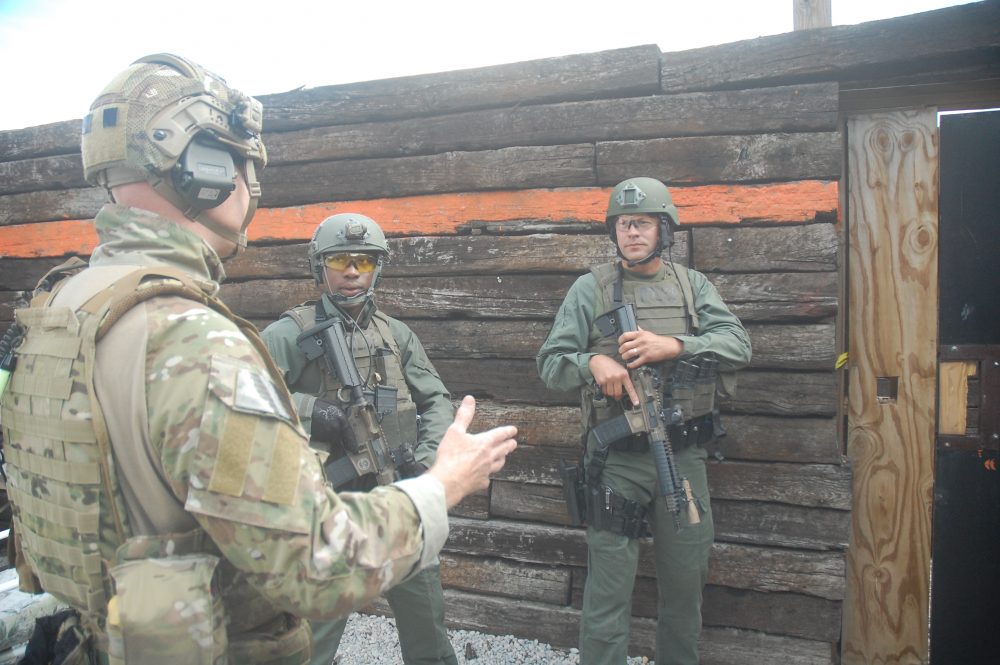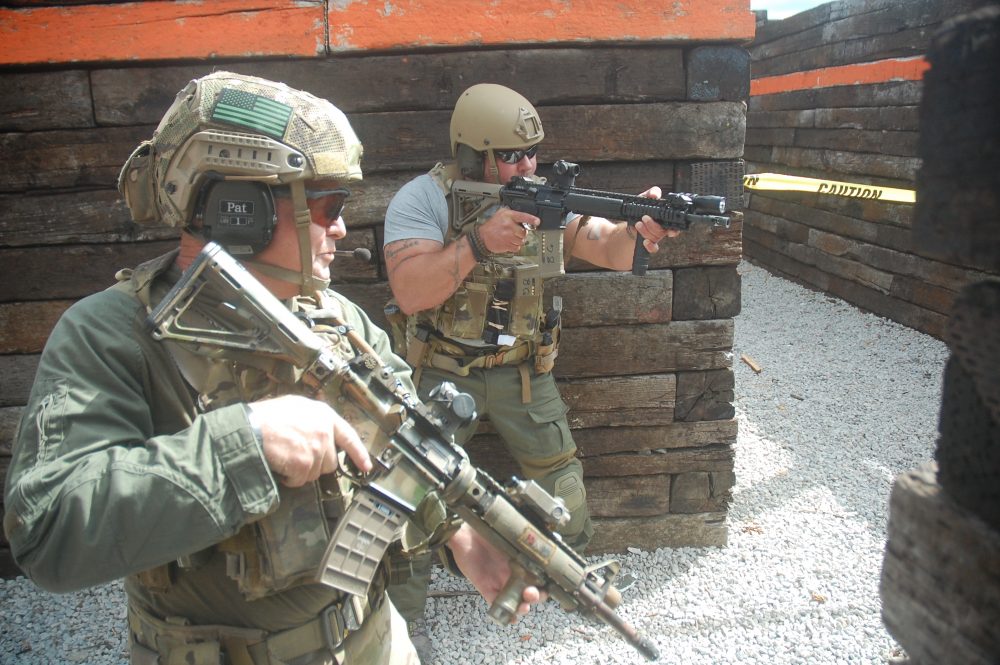The profession of arms does not suffer fools.
Authority can be delegated; responsibility cannot. The privileges of being an instructor mean that a sacred trust has been placed in me not only to provide proper advice and guidance, but also to ensure that training will be conducted in a manner that guarantees the safety of all involved. The mission is to help good guys win. There can be no compromise in the planning, development and conduct of programs that allow learning to occur while also ensuring the good guys get to go home after training.
So while the student has the responsibility to ensure he conducts himself in an appropriate manner, it is the instructor who is responsible for the entire scope of what occurs during training.
EAG instructor Mike Hueser (Mr. Grumpy) gets brief back from two hard Maryland cops. They have made ready, including their PID, weapon-mounted and handheld lights. They’ll brief back the scenario to Mike so that he and the other instructors are satisfied that they know the scenario and who will be in the house with them. Ad hocery does not work in this environment and only leads to disaster down the line.
Of all training environments, the shoot house has the greatest potential for danger. The 360-degree shooting environment, combined with the complexity of moving and shooting with others in the three-dimensional space, is the highest level of reality and difficulty in tactical training. As a result, training in this environment demands the highest level of competence on the part of the instructor. Students and instructor must maintain vigilance at all times to guarantee safety for all.
There is more to the shoot house than shooting in a house.
Table of Contents
BALLISTIC VS. NON-BALLISTIC SHOOT HOUSES
There are two basic types of shoot house, and our safety rules have to work for both. In the full ballistic shoot house, all exterior and interior walls are ballistic defeating. Non-ballistic shoot houses can have exterior walls that are ballistic defeating, providing protection to those outside the house, but have non-ballistic interior walls that offer no barrier protection to those within the edifice. This is a common kind of construction because it leaves the interior endlessly modifiable to allow for variety in the layout, which can be changed frequently.
It is also possible to have a completely non-ballistic house, where protection to those outside the house is provided solely by the berms surrounding the actual shoot house.
Regardless of the type of shoot house, our safety rules have to provide unerring protection for all involved.
Weapon-mounted light is not a luxury—it is a requirement. Light has to be sufficiently powerful to positively identify what you are looking at, a minimum of 200 lumens, preferably 500 lumens. If you cannot positively identify a target in a shoot house, engaging it is criminal negligence. This shooter had a Krill light on his back as a PID light. He has shot his threat to the ground and is now assessing.
PERSONAL PROTECTION EQUIPMENT
I am an instructor with EAG Tactical. For all our shoot house classes, the minimum required safety equipment is:
- Plates (front and back)
- Ballistic helmet
- Eye protection that follows the MIL-PRF-31013 standard and is on the Authorized Protective Eyewear List
- Earpro
- Personal identification device (PID) for night training
- Tourniquet located centrally on the body
- Individual first aid kit (IFAK)
A few words on some of these items and the rationale for their use. Stand-alone or in-combination-with-soft-armor plates that fit the operator properly are required.
At least one popular instructor is on the record as recommending shooters wear the smallest plates possible to allow the development of a better shoulder pocket for his rifle. At EAG, we prefer to teach weapon skills that reinforce the ability to operate and control the weapon despite the lack of a shoulder pocket, without sacrificing coverage by our armor. If you cannot master this skill, do not come to the shoot house. You may continue to wear your too-small plates as a fashion statement on the square range.
Our ballistic helmets, soft armor when worn, clothing and eye pro protect us from spall, the inevitable result of missiles striking immovable inelastic barriers in the shoot house. When these basic measures are taken, we have infrequently seen injuries from spall in the house.
In fact, I have seen more injuries on the square range than in the shoot house. On the square range, orthopedic injuries to knees and ankles, along with cuts from gravel, brass or sharp edges to the hands frequently occur. Due to our movement in the shoot house being careful and smooth, plus the requirement of protective equipment and the advanced skills of the students, injuries are uncommon.
Author and Mr. Grumpy with Wounded Warrior Jace Badia after a great run through a shoot house.
Beyond simple hearing protection, certain weapons systems in some environments can require extra effort to provide hearing protection. Short-barreled rifles (SBRs) produce extensive flash and painful sound and concussion in enclosed environments. Suppressors are safety devices first, and should be used whenever possible for all carbines.
However, I believe that suppressors should be mandatory for all SBRs in a shoot house environment, because their muzzle blast and concussion damage hearing. It is necessary to use ear plugs as well as electronic earpro to provide the minimum hearing protection, especially when this is multiplied by the numerous runs—and hence exposure—in the shoot house training environment.
Though not necessary for daylight training, a PID is required for night work. Some shoot houses that have a roof, when combined with the right weather conditions, can make for a dim interior environment, such that their use during daylight hours may be appropriate as well. Mounted on the back, a chemlite or battery-operated light means you can be seen. This is an essential for personnel accountability.
STUDENT RESPONSIBILITIES
Exacting attention to the four rules of firearms safety displayed during square range work is one of the first qualifications for vetting a student to be accepted into a shoot house class, but it is not the last.
A friend recently noted that the definition of being a professional at arms is no different than defining what constitutes “ethics.” Ethics is not doing the right thing simply because someone’s looking at you. It is doing the right thing when you know nobody is looking.
But in the shoot house, I guarantee you will have at least one instructor looking at you every second. Any deviation in safety with your firearm will result in immediate correction or dismissal.
Movement within the house only occurs with the mechanical safety on and the trigger finger straight. There can be no violation of this rule. Reactive targets are shot to the ground. As you evaluate the effectiveness of your intervention in successfully eliminating the threat, continue to point your weapon at the threat, with the finger on the trigger, ready to react as the threat dictates.
Two shooters enter bedroom in Appling, Georgia shoot house. They both wear a red personal identification light on their helmets, which helps instructors keep track of them. On their Carbines, both have SureFire Fury lights mounted. Fury provides 500 lumens of light so they can positively identify their target.
When the threat is deemed “eliminated,” scanning for the next threat can be done with the mechanical safety off and the finger off the trigger. When it’s time to move, the mechanical safety is engaged—without fail.
Target discrimination is vital. We use a method of identifying targets, differentiating those that are armed hostiles from unknown subjects and from good guys.
This is thoroughly briefed. Positive identification of the target must be obtained—not only as to what target can be engaged immediately, but that the target can be safely engaged with respect to others in the room. The fate of the free world does not depend on the shot being taken. If there is ever any question that the shot cannot be taken safely, students are instructed not to shoot.
Whether this is because the safety of the background is in question, a partner’s direction of travel might take him too close to the line of fire, or any reason he believes the shot cannot be safely taken, the student’s responsibility is to not take the shot. This will absolutely result in compliments to the shooter by the instructor for their mature judgment.
Another factor in target discrimination, especially at night, is a proper weapon-mounted light. A weapon-mounted light is a very good idea, but a handheld light accessible by the non-firing hand is required regardless. Volumes have been written on these subjects. Bottom line: use enough light to discriminate the target.
A light may be needed in an indoor environment during daylight hours as well to discriminate targets. Roam around your house during the day. Can you see behind the chair in the corner to clear behind it without a light? Or the master bedroom closet?
Muzzle control is another student responsibility. Beyond simply “not covering anything with the muzzle of your weapon that you do not wish to destroy,” because others are in our battle space, a limit needs to be placed on how far our muzzle can travel before causing danger to another.
Author gives in-brief to two Pentagon Force Protection Agency cops at Alliance, Ohio PD shoot house.
In general, we use the One-Meter Rule. The muzzle of your weapon cannot come within one meter of your partner’s muzzle and vice versa. Besides the projectile, muzzle blast can cause serious injury.
Students are additionally taught that the #1 shooter is always right. If your partner engages a target and his intervention is not successful, the reason there is more than one of us in the house is so that we can get more than one gun in the fight. It is appropriate for the #2 shooter to get into the fight at that point.
However, it is then the #2 shooter’s responsibility to move up to a safe position from which to provide supporting fire. Do not ever shoot from behind another shooter.
Before the first shot is fired by the student in the shoot house, these principles are taught, reviewed, and practiced until the instructor deems the student ready to take the next step.
CONTROL
Much as with dismounted patrolling operations, personnel control and accountability are the keys to success.
First, students are instructed that they may not be around or in the house without being directed by an instructor. Even in ballistic houses, there is the opportunity for rounds to exit the structure through non-ballistic doors or openings. No one can be haphazardly roaming around the exterior of the house.
A staging area is selected as a control point from which students are directed to approach the house for their next run. Generally it is also an area where the students can make ready with a safe ballistic backstop while manipulating their weapons. This control point can change throughout the course depending on the breach point chosen, but it must be designated.
Instructors have to know at all times that no student is in a non-designated area.
By the time you get to this stage of training, you’d better be switched on and have a clear understanding of what is expected. Pat Rogers and Paul Buffoni (owner of Bravo Company USA) negotiate hallway in Alliance, Ohio PD shoot house.
INSTRUCTOR TO STUDENT RATIO
A one-to-one instructor-to-student ratio is a minimum for two-man team training. Three instructors can be utilized effectively and safely, but more can be detrimental as it is difficult for that many instructors to effectively stay “behind” the students and their weapons’ muzzles throughout all movement in the house. The same holds true for training in larger elements.
Except in the largest of houses, which more closely simulate industrial-size spaces, it is not possible to have an instructor following every student. For this reason, training in elements of more than two or three individuals is an advanced training package, requiring extreme vetting of all participants. Even a basic shoot house course is an extremely advanced form of training that not every square-range-trained individual can advance to participate in.
INSTRUCTOR ORGANIZATION
Shoot house and CQB courses are work-intensive for the instructor. A variety of tasks have to be accomplished: Planning and setting up each run, logistics preparation (which is constant), giving pre-run briefings for the group and individual teams before each run, designating the breach point for the group and staging area/control point for entry and subsequent exit from the house, the actual run itself, ending the exercise and supervising students clearing weapons, post-run debrief for the individual team, exit of the team from the shoot house to the administrative area, followed by the instructors re-cocking the house and starting the process all over again.
All this has to be accomplished in a manner that is consistently repeatable and allows for no variation in its goal—a safe environment for students and instructors.
DESIGNATED INSTRUCTOR ROLES
The first opportunity for major safety issues obviously occurs during the actual runs through the house.
Among the instructors, a primary has to be selected for each run. The role of the primary is to be the overall guide of the exercise, from whom all commands are given and all commands are followed. As with all operations involving movement, this is to reduce confusion.
The primary may give instructions to students involving direction of travel, responses of unknowns within the room (including answers to interrogatives), or correcting behavior. It is not proper for all instructors to be simultaneously trying to communicate verbally with students. The student is in a stressful environment, trying to process what he is seeing and react properly. Adding to his confusion by having multiple sources of verbal commands is a negative influence in the training environment and limits the ability of the student to know whether it is he or his partner who is being verbally engaged by the instructor.
Either the primary or secondary instructor(s) controls their individual student, ensuring that no unsafe conditions are allowed. The instructor stands behind or close to the side of the student, within arms’ reach at all possible times. If the instructor needs to physically halt the student by grabbing his plate carrier, or move the student into a better physical position by encouraging him to turn, move forward, left, or right by physically and verbally prompting him, he is close enough to do so.
One of these arrangements must be used: either three instructors, one primary and two secondaries each following their respective students; or two instructors, with one of them designated the primary. He controls the overall exercise while also personally controlling a student.
The primary gives all commands from the beginning of the run until the students have made their carbines Condition Four, received their individual debrief at the end of the run while still in the house, and been directed to their egress point from the house.
At end of each iteration, entire class receives debrief, then each team can give feedback from their run. Pat Rogers and Steve Fisher interact with class. Flow of information has to be constant and straightforward.
RE-COCKING
This is the second opportunity for disaster. During this time, instructors are resetting the reactive targets and examining the rooms and all physical spaces for any damage that might present a safety issue. After ensuring the training space is again ready, they perform an exacting search from the point of “endex” (the planned end of the exercise) backwards through every room and space, closing doors behind them and returning by a reverse route to the breach point, where students’ entry into the ballistic training environment will begin.
While the instructors individually and jointly clear the space for safety as in all operations, someone must be designated the responsibility of ensuring the training space is free of any hazard or personnel before the next run can begin. This person is the house safety officer.
HOUSE SAFETY OFFICER
This can be designated formally for each run or, when familiarity is achieved, it can be informally the last instructor out of the house who has taken the responsibility of personally inspecting every foot from the endex point to the breach point, ensuring that the house is clear and ready for the next run.
When the house safety officer exits the house and announces “last man out,” it is the declaration for all to hear that this has been done correctly. This announcement assures everyone that the person stating this has personally ensured that the house is now in a safe condition to proceed with the next run.
In complex runs or large houses, it is acceptable to have other instructors or designated personnel enter the house and assist in resetting the targets. The instructors are responsible to each other at this stage to ensure that anyone assisting in re-cocking the house departs the house from the same control point, usually the breach point for the run. In this manner, a correct headcount can be maintained.
If for any reason a person helping to reset the house has to drop out, he must let the designated house safety officer know. It is tempting at the end of a long day to take a shortcut and exit the house by a different egress than the control point to avoid walking through the serpentine house over and over again. There can be no misunderstanding of who needs to be accounted for.
Likewise, during the shooter brief prior to each individual team being run through the house, the primary instructor reviews with the team the tactical scenario for the run and informs the team which instructors will accompany them into the house. When the scenario begins, all personnel—including all instructors—remain together until the run is completed, endex is announced, and all carbines are made Condition Four.
Catwalks over the shoot house are not only excellent tools for teaching and learning but also excellent safety features. Any violation of safety conditions that might not be visible to instructors within the house before or during the actual run but that can be identified from above only adds to the overall safety of the training environment.
NOT ACCEPTABLE
Most situations that endanger safety can be avoided by planning and control of the environment. But some such situations cannot. Unsafe conditions caused by flaws in the design and construction of the shoot house itself may not be preventable by even the best planning. Facilities that have these problems or have a history of accidents should be avoided at all costs.
The use of simultaneous breach points is an opportunity for disaster. Not every facility is capable of sustaining this kind of training, and not every training company or student group is capable of performing this kind of training safely.
In facilities that are capable of sustaining this kind of training, my personal rule is that there must be at least two ballistic walls between the target and any person potentially in the path of the bullets’ trajectory past the target.
This is advanced-level training in every sense. Not every facility can support this type of training by its design. In non-ballistic-wall shoot houses that depend on traps to retain bullets and their spall, this type of training should never be attempted.
Finally, there is no circumstance under which any instructor or student can be in one part of the house while another part is occupied by a shooter. Period.
All this serves only to scratch the surface of the complex subject of shoot house safety. Shoot house training is the culmination of all square range training. However, because of the 360-degree environment, an entirely different level of safety consciousness must be applied without exception.
Not everyone is capable of participating in this kind of training, and not every instructor is capable of teaching this kind of course.
John Spears is a former 18D Special Forces Medic and currently an orthopedic spine surgeon and weapons and tactics instructor for EAG Tactical.
